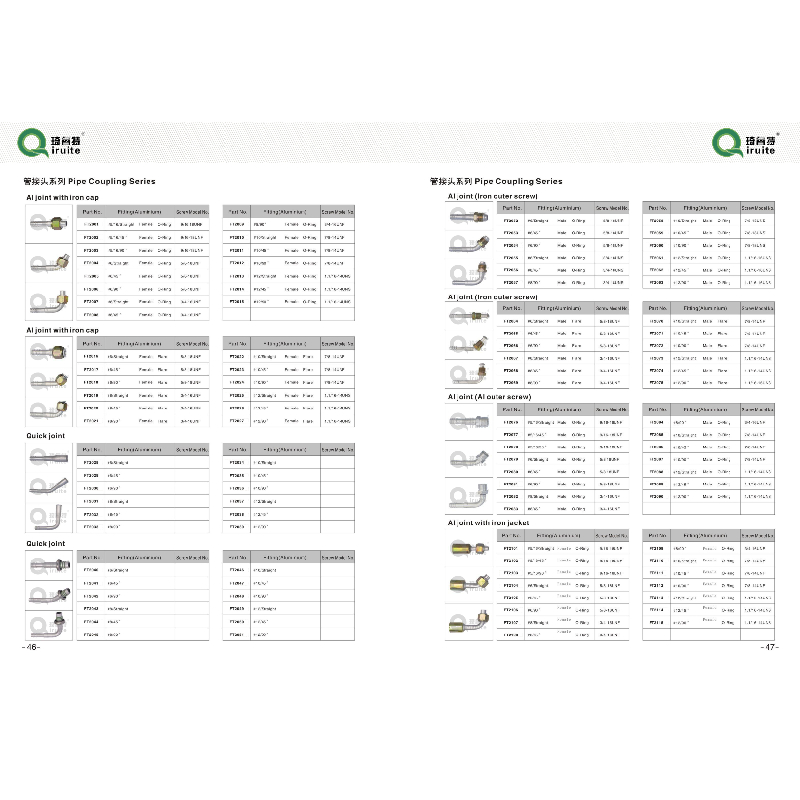Quick Release Ball Joint—Fast, Secure, Tool-Free: Need One?
A Field Guide to the Modern Quick Release Ball Joint
If you’ve specced connectors lately, you’ve probably noticed how fast the humble quick release ball joint is evolving. Honestly, it’s not just a “niche hinge” anymore—it’s become a compact, swivel-friendly way to couple lines where speed, sealing, and articulation all matter at once. I’ve seen teams swap out clunky swivels for these in test rigs and HVAC lines and never look back.

What’s trending (and why it matters)
The trend is clear: lighter alloys, cleaner sealing stacks, and connectors that won’t bind under misalignment. In fact, aluminum bodies plus reliable O-ring grooves are now the default in many HVAC and light industrial skids. Many customers say they’re speccing quick release ball joint couplings to cut assembly time and reduce warranty calls from thread galling.
Product snapshot: Pipe Coupling Type from Ningjin, Hebei
Originating from Ningjin County, Hebei Province, the Pipe Coupling Type line blends CNC’d aluminum fittings with 9/16-18 UNF threads and O-ring sealing. The part family below covers straight, 45°, and 90° geometries—handy when a rigid tube needs that last bit of articulation without fighting the hose.
| Model | Geometry | Ball/Stud Size | Thread | Body Material | Seal |
|---|---|---|---|---|---|
| FT2001 | Straight Female | ≈ #5/16 | 9/16-18 UNF | Aluminium | O-Ring (NBR standard) |
| FT2002 | 45° Female | ≈ #5/16 | 9/16-18 UNF | Aluminium | O-Ring |
| FT2003 | 90° Female | ≈ #5/16 | 9/16-18 UNF | Aluminium | O-Ring |
Process flow, testing, and service life
- Materials: 6061-T6 aluminium (body), carbon steel/SS ball-stud; NBR O-ring (FKM optional).
- Methods: CNC turning/milling, deburring, anodizing; precision groove for seal compression.
- Testing: ISO 19879 leakage/pressure; ISO 9227/ASTM B117 salt spray (96–240 h target); torque and swivel-friction checks; proof/burst verification.
- Performance: Working pressure ≈ 3.5–7 MPa (real-world use may vary). Temperature −40 to +120°C (NBR), up to +200°C with FKM.
- Service life: ≥ 50,000 articulation cycles at 10–15° oscillation with no seal weep in lab tests.
- Certifications: ISO 9001 QMS; RoHS/REACH compliance on request.
Where it shines
Typical applications: HVAC/R lines, compact hydraulic pilot circuits, test benches, motorsport fuel/air ancillaries, and food equipment (with appropriate seal choice). The big win with a quick release ball joint is that it tolerates a bit of misalignment and still seals—less wrenching, fewer callbacks.
Vendor landscape (a candid snapshot)
| Vendor | Origin | Lead Time | MOQ | Certs | Customization | Price Band |
|---|---|---|---|---|---|---|
| HoseQRT (Pipe Coupling Type) | Ningjin, Hebei | ≈ 2–4 weeks | Low | ISO 9001, RoHS | Angles, seals, anodize colors | $ |
| EU Specialist A | EU | 3–6 weeks | Medium | ISO 9001, REACH | High-mix, custom threads | $$$ |
| US Maker B | USA | Stock–4 weeks | Low–Med | ISO 9001 | Materials, coatings | $$ |
Customization and real-world feedback
Options include alternative seals (FKM/EPDM), custom UNF/metric threads, tighter swivel torque windows, and color-coded anodizing. One HVAC OEM told me their techs liked the “no-drama” torque feel; a racing team mentioned fewer leaks after switching to a quick release ball joint with FKM seals for heat soak.
Mini case studies
- HVAC retrofit: 90° units eased tight bends, cutting install time ≈ 18%.
- Motorsport: 45° joints reduced hose stress; zero weeps across a 12-race season.
- Food line pilot air: anodized aluminum with EPDM seals passed routine washdowns (check chemical chart, naturally).
Bottom line: if you’re chasing compact routing, fast service, and reliable sealing, a well-made quick release ball joint like the Pipe Coupling Type is a smart, budget-sane step forward.
Authoritative references
- ISO 7241-1: Hydraulic fluid power — Quick-action couplings — iso.org
- ISO 19879: Metallic tube fittings — Test methods for hydraulic fluid power — iso.org
- ASTM B117: Standard Practice for Operating Salt Spray (Fog) Apparatus — astm.org
- SAE J514: Hydraulic Tube Fittings — sae.org
-
Quick Release Ball Joint – Tool-Free, Durable, Leak-TightNewsNov.13,2025
-
Spiral Guard Hose Protection — Durable, UV-Resistant WrapNewsNov.13,2025
-
SAE J1401 Brake Hose Specifications: Durable, Low ExpansionNewsNov.13,2025
-
SAE J1401 Brake Hose Specifications | DOT-Approved, DurableNewsNov.13,2025
-
Spiral Guard Hose Protection - Abrasion-Resistant, UV-StableNewsNov.10,2025
-
SAE J1401 Brake Hose Specifications | DOT-Certified, DurableNewsNov.10,2025

